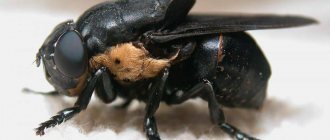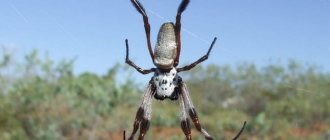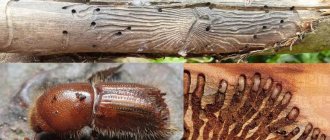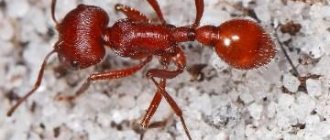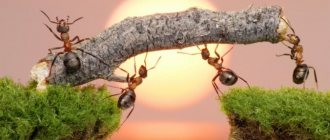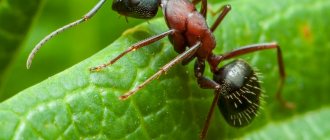History of red ants
Until 100 years ago, fire ants lived only in Brazil, until they were accidentally brought by merchant ships to a port in Alabama, USA, in the 1930s.
Having found themselves in a climate favorable to them, without encountering any opposition from the local fauna, the ants began to rapidly multiply, gradually colonizing the territories of all the southern states of North America and Mexico. Already in 2001, again with the help of sea trade, they reached Australia, New Zealand, then China, the Philippines and smaller Pacific islands.
On a note!
Many countries are studying this type of insect, conducting scientific research, developing methods for their destruction, as well as ways to treat people and animals from their bites. The total US losses equate to $5 billion annually, which is spent on medical care for injured people and animals, and on chemicals to destroy them.
In the process of developing a new territory, fire ants harm not only people and domestic animals, they displace and kill their brothers of local varieties, and can attack the nests of crocodiles, turtles and birds located not high above the ground.
Fire ant family structure
An ant family is an organized community. It contains:
1. Brood. 2. Adults. 3. Infertile females (workers).
An ant family can consist of several dozen individuals, but sometimes develops into real colonies consisting of millions of individuals living over large areas. Large families are mainly wingless, sterile females, from which castes of workers, soldiers and various other groups are formed.
Almost every family contains males and one, sometimes several reproductive females, which have a very beautiful name - queen, queen. Fire ants work as one unit, which is why the family is called a super organism. Parallels with human society, such as the division of labor, self-organization in difficult situations, and connections between family members, have long attracted the attention of scientists.
Description of the type and features
The fire ant has a very small size: females are 2-4 mm reddish-brown in color, males are darker, almost black. The photo of a red ant shows that its body consists of a head with jaws, a body, 6 strong legs, many mustaches and a stinger, which is hidden in the abdomen.
Red fire ants In nature, they build low anthills, forming mounds on the ground up to 0.5 m in height and diameter. There is a clear distribution of roles among workers who obtain food, guards, builders, the queen and nannies who feed the offspring.
Between several nests, ants build multi-meter underground passages along which they can run and, when meeting neighboring “warriors,” get involved in fights.
Interesting!
An unusual fact about ants concerns their ingenuity and ability to survive. Although ant colonies live on the ground, they often suffer from floods in their homeland. To survive, red ants were able to come up with such a means of escape as a living raft from their own bodies, fastened with powerful jaws. Such a structure can float for several weeks.
When biting, the ant uses a sting and injects the poison solenopsin, which belongs to the class of alkaloids, into several points. It causes a burning pain that feels similar to a fire burn, which is why the insect was given its name. Affected people often experience an allergic reaction, accompanied by swelling, vomiting, dizziness, anaphylactic shock and even death. Blisters appear at the site of the ant bite, and after healing they often leave scars.
Species dangerous to humans
The poisonous threat of many ant species has been greatly exaggerated, but there are still several species whose bite is very dangerous to humans. Below are several species of these insects, encountering which is fraught with disastrous consequences for humans:
- Bullet Ant. These most dangerous ants in the world received this name due to their ability to hit warm-blooded animals like a bullet. These insects rank second in the world in terms of danger. Their habitats are tropical trees, from which they “dive” on prey that approaches their nests. The body of the insect is quite large, reaching 3 cm in length, and is covered with thin needle-like spines. Color dark red-brown. A peculiarity of these predators is the sound signal before an attack, warning the potential victim of danger. If the warning is ignored, the insect attacks, causing pain from the bite comparable to being hit by a bullet. The painful sensations last for 24 hours, for which they received another name among the natives of Central America - “24-hour ant.” For people suffering from allergic reactions, a bite from this insect can be fatal. The poison contained in it paralyzes the affected limbs, causing severe pain and convulsions. If several individuals attack at once, death is very likely.
- Stray or nomadic ants. In America they are also called “military”. These insects lead a nomadic lifestyle, moving around in search of food. A distinctive feature of this species is its powerful and sharp jaws, with the help of which the insect deals with the victim. These man-eating ants, native to South America and Africa, pose a serious threat to human habitations, and can only be saved by fire or flight.
- Fire ants. These pests were recently brought to America from Brazil and have already gained fame as one of the most dangerous representatives of the insect class. Their bite is like a fiery burn, causing redness and swelling of the affected area. They live in the countries of America, Europe and Asia and very quickly adapt to different living conditions, populating more and more new territories. After their bites, which cause a severe allergic reaction, swelling, nausea, vomiting and dizziness may occur. During the year, about 20 cases of death from bites of these insects are recorded.
Organization of life
Ant Reproduction
The fire ant has a standard life support system. Families consist of three clans:
- Uterus.
- Working individuals.
- Brood.
Unlike other brothers, in the fire family there can be several individuals responsible for laying eggs. This allows them to reproduce at an impressive speed. Working individuals are females who are not capable of reproducing offspring.
The brood group includes all life stages up to the sexually mature individual: eggs, larvae and pupae. Their development is completely dependent on adults. The individuals responsible for the population hide the future cubs as deep as possible in the anthill and carefully monitor their diet.
Fire ants try to arrange their home as close as possible to the food source. This could be agricultural land or human habitation. That is why in countries where representatives of the fiery species are found, active work with the population is carried out. They regularly broadcast photos of the red ant, warning about the danger of its bite and how to detect it. It is also mandatory to carry out chemical treatment of agricultural objects, veterinary control of livestock and first aid training for bites.
What does an insect look like?
During its life, the fiery species of ants goes through four stages:
- egg;
- larva;
- chrysalis;
- adult.
The photo shows a red fire ant larva, which, unlike the adult, is white and absolutely immobile. Accordingly, she cannot obtain food for herself. The larva is completely supported by the worker ants until it gains the necessary weight and acquires the size to transform into a pupa.
A day before turning into a pupa, the larva stops consuming food and completely empties the intestines. Working individuals find suitable conditions for the pupa and serve it until a new ant is born from it.
Adult ants, judging by the photo, are not large in size. The length of their body is two to six millimeters, and depends on the region in which the insect lives. It is surprising that in one nest there can be individuals, both the smallest and the largest. Fire ants, although called red ants, can range in color from dark red to brown. At the same time, the abdomen of adult individuals is almost black. The body of the goosebump consists of a head, chest, abdomen, and it also has six legs, very strong and powerful.
Fire ant nutrition
It may seem strange, but these insidious predators have some benefit. They eat crop pests:
- grains and legumes;
- rice;
- sugar cane, etc.
But there is still more harm. from fire ants, which have to change their morphology, behavior and lose eggs.
Insects do not get along with their “relatives”, their own kind, competing for food. They are not only predators, but also herbivores. In the photo, the fire ant is almost always captured carrying something on its back for construction or food:
- shoots, plant stems;
- various bugs, caterpillars;
- larvae;
- reptiles.
Fire Ant Source
Ants live with their families in nests, which are earthen mounds and are called anthills. Insects construct this source in the soil, under a stone or in wood. Some people use small plant particles to create an anthill.
Between the nests of fire ants there are tunnels through which they move freely in different directions. They can wander for a long time in search of food; during such trips, meetings with representatives of another colony often occur. During such unwanted encounters, fights break out between belligerent goosebumps.
Stopping at a rest stop where a fire ant nest is located is unsafe for a person who has allergic reactions. After all, ants not only have a terrifying appearance, but their attack can lead to irreversible processes in the body of a living creature.
Behavior
They live in anthills, which are most often built in open areas. Anthills are mounds of soil on the surface of the earth. Their diet consists of young succulent plants and seeds.
They also attack insects and small animals, inflicting a bite with a stinger, they easily cope with their victims. They bring their victims to the anthill to feed those individuals that do not leave the territory, as well as to feed the offspring.
Regarding the solenopsin poison, which they secrete during an attack, it is deadly for insects and small animals. If an ant attacks a person, the poison causes very painful sensations, very similar to a burn. The effect on the human body is individual, but sensitive people tolerate its effects very hard, in some cases it can lead to death.
They are among the most aggressive insects, relative to ants of other species, and they easily displace them from territories.
They adapt very well to new conditions and can easily tolerate frosts.
Fighting methods
Extermination of insects always requires an integrated approach. In apartment buildings, the efforts of all residents will be required, since treating one room will not produce results. To eliminate red ants, you need to take the following steps:
- general cleaning of all premises
- chemical treatment
- preventive work
The very first step is cleaning. Be sure to throw out all the trash, move the furniture, carefully pack the food, ventilate the closets and shake out all things. All visible cracks must be eliminated.
Long-acting chemicals are considered the most effective. The treated individuals manage to return to the anthill and infect their relatives. Aerosols are used for these purposes; they are convenient to spray in hard-to-reach places. To enhance the effect, you can use poisons in the form of gels and crayons; they are used to treat corners, baseboards, and the back walls of furniture.
Among folk remedies, boric acid is considered the most effective remedy. This cheap product causes the death of small colonies; the powder should be scattered in places where insects are expected to be located. To prevent the reappearance of pests, you can use strong-smelling substances - essential oils of cumin, lavender, lemon.
Previous post Where do bedbugs come from in an apartment or house?
Next entry Do cockroaches fly, cockroaches with wings: description, photo, video
Reproduction
Their natural habitat is natural conditions, but this does not prevent them from coming into residential areas and settling into colonies there. Regardless of where they decide to settle, scout ants first explore the territory.
Their task is to check the conditions of the nest and check the food sources; these are the main criteria for finding a habitat. When the territory approaches, the old colony begins to move. The main individuals of the colony are the male and female, who have wings; they fly to the new nest almost first.
This species has a unique ability; reproductive individuals can reproduce offspring independently if necessary to replenish the ranks of worker ants. The uterus is engaged in replenishing offspring; it reproduces female and male individuals. One queen can lay 250 thousand eggs in her lifetime.
Not all representatives of this species spend time arranging their homes and building anthills. For example, in Argentina, goosebumps can choose a reptile's nest for their colony; they drive out the caimans and occupy warm housing.
But they don’t stop there; the offspring of reptiles that remain in the nest are doomed to death. Ants eat the eggs, not giving the slightest chance for development and survival.
Regarding their own offspring, larvae emerge from the eggs, which in appearance resemble worms. Individuals at this stage of development are absolutely helpless; they are not able to feed themselves, develop, and even more so survive without the help of working individuals.
The larva must go through several molts, with each molt its body weight increases and its size increases, then it degenerates into a pupa. She is also looked after by working goosebumps, when the time comes to move to the next stage, they help her get out of their cocoon.
Lifestyle
Ants are one of the most amazing insects found in nature. To begin with, without having a sufficiently developed brain, they are able to perform clearly organized joint actions to protect their family and obtain food. The structure of the ant family is even more amazing. It is divided into specialized groups, each of which performs its own strictly defined work.
Ant colony structure
Red ants have the following colony structure:
- individuals reproducing offspring;
- worker ants;
- brood
The queen is a female that continuously lays eggs throughout her life. Red ants have several of them, which contributes to the rapid reproduction of these insects. The uterus, or as it is also called the queen, is very similar in appearance to working individuals, but unlike them, it is large in size.
The worker red ant is a female with an underdeveloped ovipositor. Their main function is to collect food, protect the family and care for the younger generation. Worker ants, like the queen, develop from fertilized eggs, but the development of their ovipositor is suspended.
Brood - eggs, larvae and pupae, are located deep in the bowels of the nest. They are absolutely helpless and depend entirely on the care of worker nanny ants.
What do they eat?
Red ants are omnivores. In the wild, they feed on plant sap, grass seeds, insects, tree fruits, and the corpses of dead animals. On occasion, they will attack a wounded animal, a helpless cub, or a chick. Even a person can become their victim if he cannot escape from them in time.
Settling in human dwellings, red ants eat cereals, bread, butter, sugar, meat, fruits, and vegetables. Any food that is not cleared from the table in time can serve as food for them. They will not disdain clothes made from natural fabrics, leather book bindings, or wallpaper paste. They will eat paper, cardboard and cellophane if they contain something tasty for them. Red ants, having settled in an apartment, can even feast on the insulating winding, often causing short circuits in electrical wires and fires.
Where live?
In nature, red ants usually settle closer to a source of food and water. They form especially large colonies in tropical forests with a hot climate and high humidity. In city conditions, they make their nests under the asphalt surface of sidewalks and highways, traffic lights, and street telephones.
Making their way into houses, insects settle wherever there is a space more or less suitable for them in size. They can be found especially often in the following places:
- inside household appliances;
- computers;
- air conditioners;
- under baseboards;
- between ceilings;
- in kitchen cabinets;
- under loose wallpaper.
Under the protection of human buildings, in warmth and satiety, they multiply with incredible speed, as the colony grows, capturing more and more new spaces, eventually spreading throughout the house.
How do they reproduce?
Red ants reproduce sexually. They have females and males that emerge from the nest shortly before breeding. They, unlike asexual individuals, have wings and can fly. Mating usually occurs in the air above the anthill, after which the males die, and the females look for a suitable place to create a colony.
After laying eggs, females chew off their wings and lose the ability to fly. All the time, right up to the appearance of worker ants, they do not feed and exist only due to previously accumulated reserves of nutrients. They feed the first larvae hatched from the eggs with a specially secreted secretion, and when the workers emerge from the cocoons, they are exclusively engaged in laying eggs.
The development of red ants follows the pattern of complete transformation of insects. It includes the following stages:
- egg
- larva
- doll
- imago.
The eggs are very small - up to 0.5 mm in length. They are white in color and covered with a white shell. The worm-like larvae that emerge from them are poorly adapted to independent life. They are fed and cared for by nurse ants, who rarely leave the nest and receive food from worker ants. During its development, the larva goes through 4 stages of molting, which end with pupation. Depending on the specialization, a female, male or worker ant emerges from the pupa.
Species diversity
There are up to 300 species of ants in Russia, most of which live in forested areas. Insects are not easy to classify. This is due to the existence of doubles and hybrids that are difficult to distinguish by appearance.
There are the following common types of ants:
Red forest
The red ant is the most recognizable inhabitant of Russian forests. It is these goosebumps that build the ant domes that are found near every tree. A representative of large size. The body length is sometimes 14 mm. The color of the insect may change. The color of the lower body and chest is rich red, black-brown in the belly area.
Forest ants are predatory. Nutrition basis:
- sweet secretions of aphids;
- insects;
- small invertebrates.
Important information! The species acts as a forest protector. Can destroy various insects that threaten green spaces. In one day, the animals of one house bring more than 20,000 pest pupae.
These ants are classified as an endangered species; their numbers are constantly decreasing. Humans are partly to blame for destroying and capturing animals to prepare the folk remedy.
Pharaonic
The birthplace of goosebumps is Egypt. Working animals are yellow in color, without wings. Grows no more than 2 mm. Males are black, with wings, the body length reaches 3.5 mm. The color of females is yellow-brown, the body is 4.5 mm.
Habitat: dark, damp areas, behind wallpaper, fabrics, and household appliances. The anthill does not have a generally accepted type; the ants live in mixed nests, so it is difficult to remove insects.
The best means to get rid of pharaoh ants in an apartment
Interesting fact! The mixture of acids secreted by pharaoh ants has a fatal effect on bedbugs. If there is a high content of goosebumps in the room, the bedbugs die.
Meadow
Medium size variety 5-10 mm. On the body, which is covered with coarse hairs in front of the chest, there is a spot with precise dark features. Meadow insects are similar in description to forest goosebumps. They live in the forest in clearings, meadows, and edges. Meadow individuals prefer to feed on:
- aphid secretions;
- dead invertebrates;
- live insects.
Interesting fact! The peculiarity of the species is the ability to reproduce twice a year. Active copulation is observed towards the end of spring and beginning of autumn.
Nomadic
0 This type of ant is called nomadic because of the lifestyle of its representatives. Insects do not have their own nest; they constantly travel, stopping only for a while to replenish their population. Then, from their own bodies, they construct temporary housing that resembles a large lump. In its center the queen lays eggs. With the advent of young offspring, the ant family “lifts anchor” and goes in search of another feeding territory. Interesting! Enormous fertility is the main feature of the queen of nomadic ants. Every day, about 130,000 individuals are born from the eggs she lays. Nomads are relatively large individuals (their body length reaches up to 15 mm), which is why they often find themselves in the ranking of the largest ants in the world. What catches your eye is the frightening-looking jaws of the insect, the size of which even exceeds the dimensions of the head. The female is larger than the male; during the period of laying eggs, her body size can reach up to 5 cm. Photos of nomads can be seen below. The insects are found in Africa, Central and South Asia, and North and South America. They are called killer ants because the nomads destroy all living creatures they come across on their way. These can be not only small insects; representatives of this species are able to feed even on small rodents and reptiles.
Yellow ants
Another species that also actively parasitizes the human home. Yellow ants have another, more characteristic name - pharaoh ants. And the reason is that they were first discovered in Egyptian crypts, where the pharaohs rested.
Yellow ants prefer dark, damp and warm places: cracks in walls, flooring, in household appliances and behind peeling wallpaper. Within a human home, this species organizes a whole system of nests that are connected to each other. It is difficult to get rid of these pests: if you destroy one nest, the insects simply run to another.
Red ants
The red ant came to our latitudes straight from South America, or rather, it was brought from there. People tend to call this species fire ants. The body of an adult individual has a length of 3 to 6 millimeters. Their home is soil or other places with high humidity. The diet is based on plants, young seedlings and other insects. Red ants can be quite aggressive, and the poison they secrete can help defeat a larger enemy.
Forest ants are often mistaken for red ants because of their similar color. In fact, this is a separate species of insects, found, as you might guess, in the forest. Living in the wild, they are true predators whose favorite food is caterpillars.
Bullet
0 These species of ants are not found in Russia; their habitat is the tropical forests of Nicaragua and Paraguay. Representatives of this species build their nests in tree trunks, trying to disguise them with branches and leaves. 0 Bullet ants are very dangerous insects. Their bite is accompanied by severe pain that does not subside throughout the day. The injured areas become charred and turn black. The consequences of such ant attacks are the occurrence of tumors, paralysis, chills and weakness.
Bulldogs
0 Ants of this breed began to be called bulldogs because of their large jaw, thanks to which insects obtain food. They also use it to push off the ground and can jump up to 0.3 m. Adult ants are good swimmers. The larvae eat the food obtained by the workers themselves. Representatives of this species prefer a tropical climate, so they can only be found on the Australian continent. In appearance, they are very similar to wasps: they have a large body, the size of which reaches up to 30 mm. You can see what a bulldog ant looks like in the photo. The bulldog ant poses a serious danger to humans. The consequence of its bite can be an allergic reaction, and even anaphylactic shock.
Black garden
A common species is black garden ants. A large number of them inhabit the territories of Portugal, Great Britain, and Russia. The black or dark brown body of the insect has many short hairs. The main food product is sweet honeydew, separated by aphids.
If compared with the reaper, the black ant, although it has the same body color, will differ in size. The black ant is considered a garden pest, as it breeds aphids and scale insects on plants.
Interesting! A queen queen can live up to 30 years.
Palefoot
The habitat of the pale-footed ant is the foothill zone, forests. It can live near the banks of rivers and construction canals in the desert. Individuals are flexible, so they get along under the bark of trees, stumps, and make nests on the ground.
Insects are capable of destroying soil insect larvae. The predator obtains the corpses of insects; it actively attacks living organisms with soft integuments. Mating years are recorded in late spring and summer. The founding of a family is carried out by the female independently.
Woodworms
Ants are often observed on trees where they collect honeydew. The name wood borer was obtained due to the construction of farms by individuals in the bark of trees. When animals gnaw out passages and chambers, they cause great harm to the forest.
The insect's body is black and shiny. There are such ants with a light sternum and a dark brown head. It reaches 10 mm in length. They prefer to consume aphid secretions. For the construction of a house, rotten stumps, wood from fallen trees, and old wooden buildings are selected. Animals descend to the ground to move to a tree located nearby.
Damage caused
We can safely classify this species as a dangerous pest. Even a small colony can quickly make life unbearable. The most unpleasant moments of being next to red ants:
- quickly destroying food supplies;
- spread of dirt and infections throughout the house;
- Chipboard furniture, paper wallpaper, books and paintings also suffer from insects.
- when attacking a person, swelling and a rash may appear at the site of the bite, the person feels severe dizziness and nausea;
- If a large number of insects attack at the same time, anaphylactic shock and even death may occur.
Ant colonies often cause fires in apartments and private houses. Damaged insulation of electrical wiring of household appliances causes a short circuit, leading to fire.
Nomadic ants
The second most dangerous species is considered to be nomadic ants. As the name suggests, these tiny creatures cannot live in the same place all the time and often move from place to place. There are up to 22 million individuals in the colonies of the African species Dorylus wilverthi. The body size of ants also reaches 15 millimeters, and their jaws, which are larger than their heads, give them a terrifying appearance. The colony's movement speed is about 20 meters per hour. At the same time, soldier ants walk along the edges of the column and are ready to attack anyone.
Head of an African nomadic ant
Thus, columns of nomadic ants sometimes destroy almost everything that comes in their way. It doesn’t matter who it is: larvae, adult insects, snakes and rodents - the tiny creatures seem to be devoid of a sense of fear. But they can’t really harm people. Yes, in rare cases, their venom can cause the aforementioned anaphylactic shock in victims, but deaths are extremely rare. But these creatures would clearly be worth adding to the list of dangerous ants.
Do you know who “hell ants” are and why they look so strange?
Danger to animals
They are no less dangerous for animals; when attacked, the animal experiences severe pain. There is also a possibility of death. If a dog is bitten by such a creep, it will begin to develop pustular dermatosis, swelling and erythema will appear. Throughout the day, the animal suffers from symptoms.
They bite livestock in areas where there is the least amount of hair, so the belly area, ears and face are often affected. If goosebumps attack young livestock, most often this leads to blindness of the animals, in some cases to their death. These insects often attack weak individuals, who are less protected than strong and healthy ones. When treating animals, corticosteroids, antibiotics, and ointments are used.
There are known cases of attacks on rabbits, ferrets, squirrels, owl chicks, etc., all symptoms develop identically. These killer insects cause the death of livestock. When an animal is attacked, it licks the bitten areas in pain, which leads to them swallowing these bugs.
Once inside the animal, they remain alive for some period of time and continue to sting, which additionally causes damage to the gastrointestinal tract.
As you can see, the harm they cause is simply enormous, and in the United States enormous amounts of money, effort and time are spent on fighting them, but, unfortunately, it is not possible to get rid of such killers. Various control methods are used, helicopters are used to spray insecticide, people dig up anthills on their own using special equipment to completely destroy the nest, they pour boiling water over the colonies, but this does not bring results, people and animals continue to suffer, and food supplies are also destroyed.
After many years of struggle and the use of numerous methods, it has been proven that the most effective way to get rid of these terrible ants is the humpback fly.
She does not eat ants, but uses a very effective method of destroying individuals. This fly lays its offspring directly on living ants; they carry the eggs on themselves until the larva hatches, which kills the ant using a special enzyme. The enzyme eats away the ant's head, which allows the larva to feed and develop.
Fire ant in Russia
In Russia, tropical “barbarians” are very rare. The harsh climatic conditions of the country are not suitable for them. But fire ants were once discovered in a Moscow hospital. Basically, although these insects are found, they are small colonies that settle next to people in warm homes.
Red and red ants live in Russia. Although they are called fiery, they are not as aggressive as their tropical counterparts. These insects build their nests – anthills – in coniferous and deciduous forests. This species of goosebumps destroys harmful insects, which is considered important for people.
Harm to humans
In addition to destroying food supplies and damaging property, red ants can cause a fire because, in the absence of food, they begin to chew on the insulation of electrical wires. But the main danger is represented by bites, during which the insect injects a strong poison into the human body, which can cause an attack of suffocation, bronchial asthma, and skin rashes in people prone to allergies.
In addition, the affected areas begin to itch very much, and the following appear:
- redness;
- rashes;
- swelling;
- signs of intoxication.
Multiple bites can cause:
- dizziness;
- loss of consciousness;
- respiratory arrest;
- death.
First aid for a “monster” bite
At the first suspicion of a dangerous insect bite, you should quickly move away from the place where the source of fire ants is located. This must be done carefully so as not to cause unrest in the “family.” Usually, sentinel individuals begin to bite first.
You won’t be able to shake off the insects, which means you need to carefully remove them from clothing and parts of the body. They cannot be crushed, because crushed ants emit a smell, through which other members of the family receive a signal of danger and immediately begin a new attack. After this, you need to free the affected area of skin from clothing in order to reduce swelling. Rinse the area, then place a cold compress on it. Be sure to take an antihistamine. Then seek help from a medical facility. Delay can be costly because the venom is a strong allergen that often causes pulmonary edema.
Treatment of bites
Since the poison released by a red ant bite is extremely toxic, the skin in this area will turn red and hurt for some time. The biggest danger in this case is infection. As a rule, the bite site is very itchy, and scratching can quickly introduce pathogens into the wound. When bitten by an ant, the procedure should be as follows:
- The bite site should be thoroughly washed with plenty of soap and water.
- Treat the wound with a disinfectant (hydrogen peroxide, alcohol, cologne).
- If a person is prone to allergies, taking antihistamines would be appropriate.
- You can get rid of burning and pain with the help of special ointments that have an analgesic effect.
If there are more than ten bites on the skin, you should immediately consult a doctor. Ant venom in large quantities can be life-threatening.
Sources
- https://apest.ru/muravi/vidy-muravev/krasnye-muravi/
- https://notklop.ru/muravi/vidy-muravev/krasnye-muravi/
- https://givotniymir.ru/ognennye-muravi-obraz-zhizni-i-sreda-obitaniya-ognennyx-muravyov/
- https://KlopVred.ru/muravi/ognennye-muravi/
- https://GdeKlop.ru/muravi/vidy/
- https://fishki.net/2658397-vidy-muravyev-v-rossii-i-mire.html
- https://eco-stolica.ru/%D0%B4%D0%B5%D0%B7%D0%B8%D0%BD%D1%81%D0%B5%D0%BA%D1%86%D0%B8 %D1%8F/%D0%BC%D1%83%D1%80%D0%B0%D0%B2%D1%8C%D0%B8/%D0%BE_%D0%BC%D1%83%D1%80 %D0%B0%D0%B2%D1%8C%D1%8F%D1%85
- https://vermins.net/muravi/krasnye-muravi.html
- https://vredinfo.ru/muravi/krasnyie-muravi
- https://FB.ru/article/253705/ognennyie-muravi-opisanie-i-foto
[collapse]
